Xiang Shi
Network Technology Lab., Huawei Technologies Co., Ltd
Interplay Between Belief Propagation and Transformer: Differential-Attention Message Passing Transformer
Sep 19, 2025Abstract:Transformer-based neural decoders have emerged as a promising approach to error correction coding, combining data-driven adaptability with efficient modeling of long-range dependencies. This paper presents a novel decoder architecture that integrates classical belief propagation principles with transformer designs. We introduce a differentiable syndrome loss function leveraging global codebook structure and a differential-attention mechanism optimizing bit and syndrome embedding interactions. Experimental results demonstrate consistent performance improvements over existing transformer-based decoders, with our approach surpassing traditional belief propagation decoders for short-to-medium length LDPC codes.
Understanding Stragglers in Large Model Training Using What-if Analysis
May 09, 2025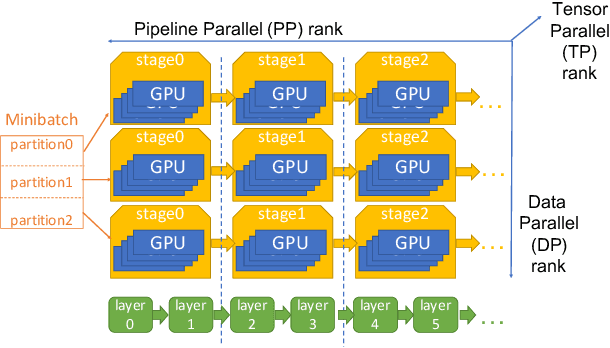

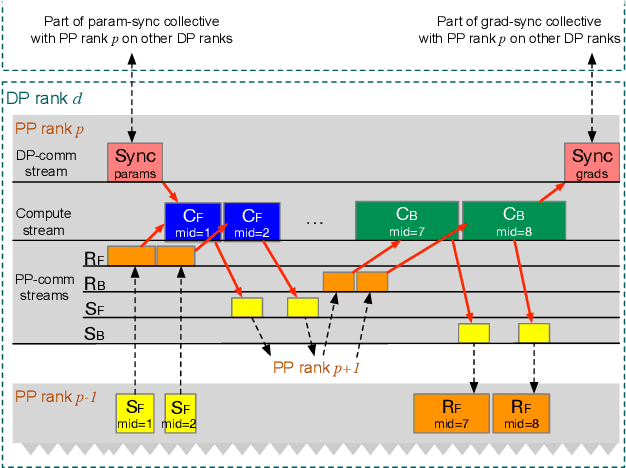
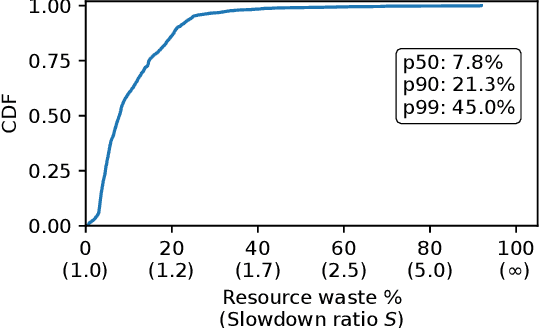
Abstract:Large language model (LLM) training is one of the most demanding distributed computations today, often requiring thousands of GPUs with frequent synchronization across machines. Such a workload pattern makes it susceptible to stragglers, where the training can be stalled by few slow workers. At ByteDance we find stragglers are not trivially always caused by hardware failures, but can arise from multiple complex factors. This work aims to present a comprehensive study on the straggler issues in LLM training, using a five-month trace collected from our ByteDance LLM training cluster. The core methodology is what-if analysis that simulates the scenario without any stragglers and contrasts with the actual case. We use this method to study the following questions: (1) how often do stragglers affect training jobs, and what effect do they have on job performance; (2) do stragglers exhibit temporal or spatial patterns; and (3) what are the potential root causes for stragglers?
Scalable Hierarchical Reinforcement Learning for Hyper Scale Multi-Robot Task Planning
Dec 27, 2024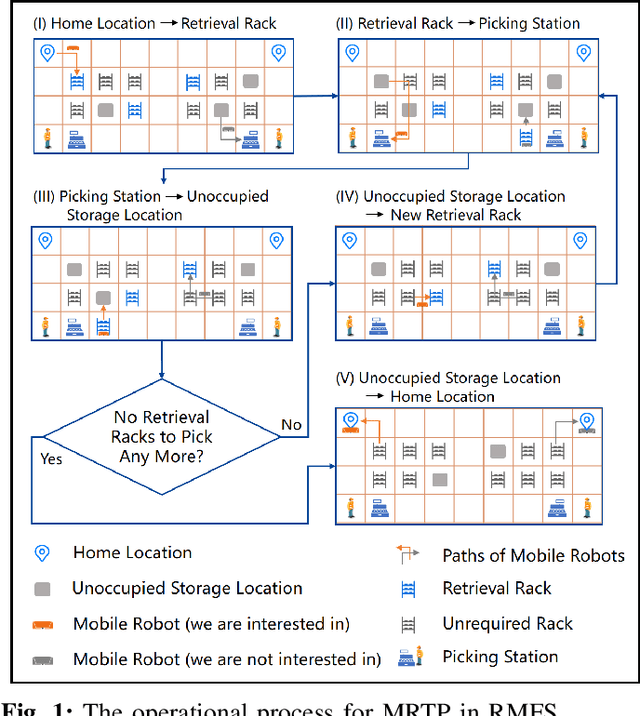
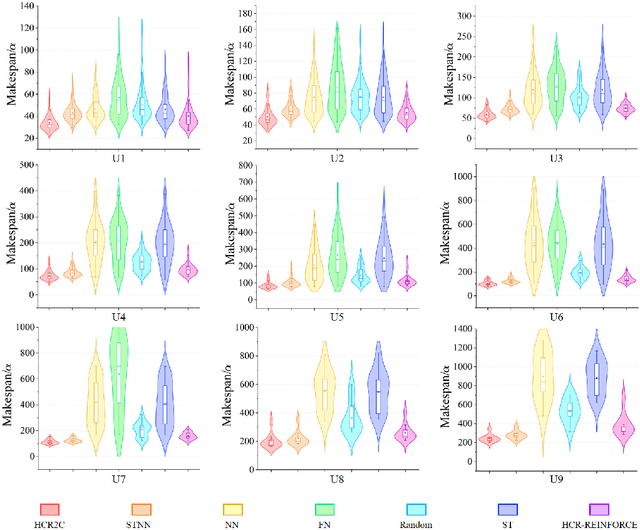
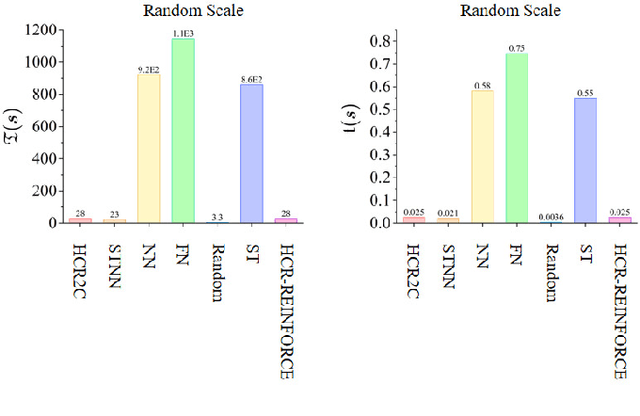
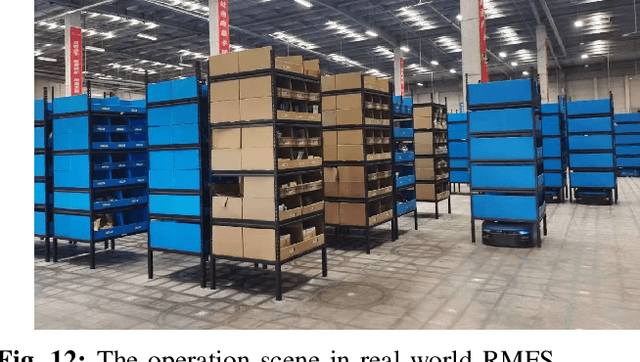
Abstract:To improve the efficiency of warehousing system and meet huge customer orders, we aim to solve the challenges of dimension disaster and dynamic properties in hyper scale multi-robot task planning (MRTP) for robotic mobile fulfillment system (RMFS). Existing research indicates that hierarchical reinforcement learning (HRL) is an effective method to reduce these challenges. Based on that, we construct an efficient multi-stage HRL-based multi-robot task planner for hyper scale MRTP in RMFS, and the planning process is represented with a special temporal graph topology. To ensure optimality, the planner is designed with a centralized architecture, but it also brings the challenges of scaling up and generalization that require policies to maintain performance for various unlearned scales and maps. To tackle these difficulties, we first construct a hierarchical temporal attention network (HTAN) to ensure basic ability of handling inputs with unfixed lengths, and then design multi-stage curricula for hierarchical policy learning to further improve the scaling up and generalization ability while avoiding catastrophic forgetting. Additionally, we notice that policies with hierarchical structure suffer from unfair credit assignment that is similar to that in multi-agent reinforcement learning, inspired of which, we propose a hierarchical reinforcement learning algorithm with counterfactual rollout baseline to improve learning performance. Experimental results demonstrate that our planner outperform other state-of-the-art methods on various MRTP instances in both simulated and real-world RMFS. Also, our planner can successfully scale up to hyper scale MRTP instances in RMFS with up to 200 robots and 1000 retrieval racks on unlearned maps while keeping superior performance over other methods.
Minder: Faulty Machine Detection for Large-scale Distributed Model Training
Nov 04, 2024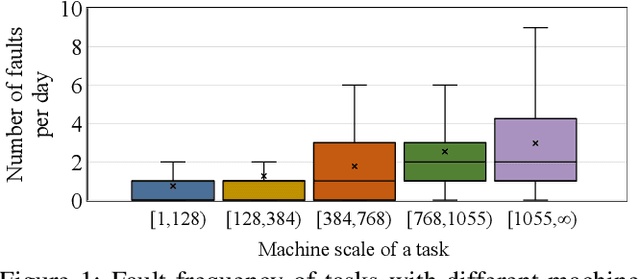
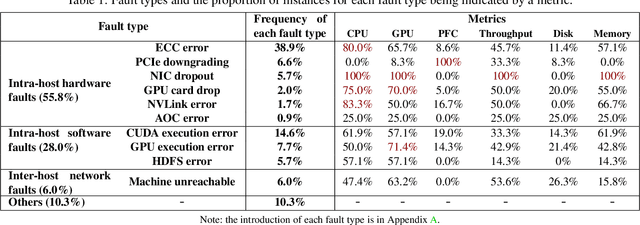
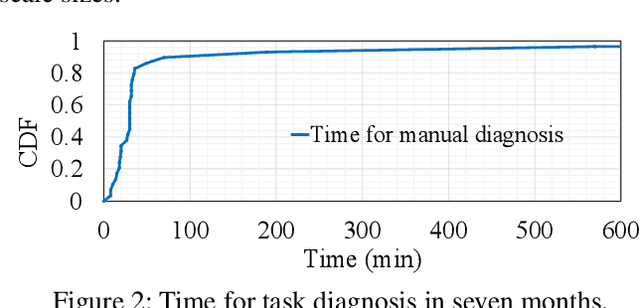
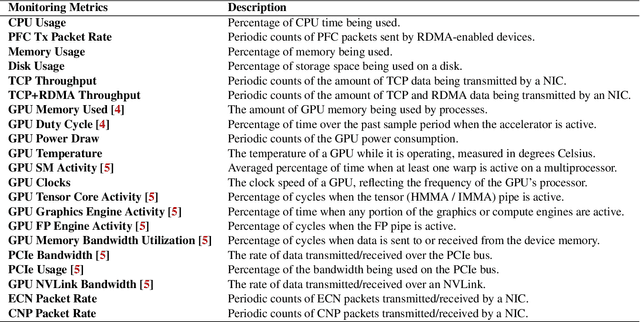
Abstract:Large-scale distributed model training requires simultaneous training on up to thousands of machines. Faulty machine detection is critical when an unexpected fault occurs in a machine. From our experience, a training task can encounter two faults per day on average, possibly leading to a halt for hours. To address the drawbacks of the time-consuming and labor-intensive manual scrutiny, we propose Minder, an automatic faulty machine detector for distributed training tasks. The key idea of Minder is to automatically and efficiently detect faulty distinctive monitoring metric patterns, which could last for a period before the entire training task comes to a halt. Minder has been deployed in our production environment for over one year, monitoring daily distributed training tasks where each involves up to thousands of machines. In our real-world fault detection scenarios, Minder can accurately and efficiently react to faults within 3.6 seconds on average, with a precision of 0.904 and F1-score of 0.893.
Every Part Matters: Integrity Verification of Scientific Figures Based on Multimodal Large Language Models
Jul 26, 2024



Abstract:This paper tackles a key issue in the interpretation of scientific figures: the fine-grained alignment of text and figures. It advances beyond prior research that primarily dealt with straightforward, data-driven visualizations such as bar and pie charts and only offered a basic understanding of diagrams through captioning and classification. We introduce a novel task, Figure Integrity Verification, designed to evaluate the precision of technologies in aligning textual knowledge with visual elements in scientific figures. To support this, we develop a semi-automated method for constructing a large-scale dataset, Figure-seg, specifically designed for this task. Additionally, we propose an innovative framework, Every Part Matters (EPM), which leverages Multimodal Large Language Models (MLLMs) to not only incrementally improve the alignment and verification of text-figure integrity but also enhance integrity through analogical reasoning. Our comprehensive experiments show that these innovations substantially improve upon existing methods, allowing for more precise and thorough analysis of complex scientific figures. This progress not only enhances our understanding of multimodal technologies but also stimulates further research and practical applications across fields requiring the accurate interpretation of complex visual data.
Let's Learn Step by Step: Enhancing In-Context Learning Ability with Curriculum Learning
Feb 16, 2024



Abstract:Demonstration ordering, which is an important strategy for in-context learning (ICL), can significantly affects the performance of large language models (LLMs). However, most of the current approaches of ordering require additional knowledge and similarity calculation. We advocate the few-shot in-context curriculum learning (ICCL), a simple but effective demonstration ordering method for ICL, which implies gradually increasing the complexity of prompt demonstrations during the inference process. Then we design three experiments to discuss the effectiveness of ICCL, the formation mechanism of LLM's ICCL capability, and the impact of ordering subjects. Experimental results demonstrate that ICCL, developed during the instruction-tuning stage, is effective for open-source LLMs. Moreover, LLMs exhibit a weaker capacity compared to humans in discerning the difficulty levels of demonstrations. We release our code at https://github.com/61peng/curri_learning.
Know Where to Go: Make LLM a Relevant, Responsible, and Trustworthy Searcher
Oct 19, 2023Abstract:The advent of Large Language Models (LLMs) has shown the potential to improve relevance and provide direct answers in web searches. However, challenges arise in validating the reliability of generated results and the credibility of contributing sources, due to the limitations of traditional information retrieval algorithms and the LLM hallucination problem. Aiming to create a "PageRank" for the LLM era, we strive to transform LLM into a relevant, responsible, and trustworthy searcher. We propose a novel generative retrieval framework leveraging the knowledge of LLMs to foster a direct link between queries and online sources. This framework consists of three core modules: Generator, Validator, and Optimizer, each focusing on generating trustworthy online sources, verifying source reliability, and refining unreliable sources, respectively. Extensive experiments and evaluations highlight our method's superior relevance, responsibility, and trustfulness against various SOTA methods.
GraphCC: A Practical Graph Learning-based Approach to Congestion Control in Datacenters
Aug 09, 2023



Abstract:Congestion Control (CC) plays a fundamental role in optimizing traffic in Data Center Networks (DCN). Currently, DCNs mainly implement two main CC protocols: DCTCP and DCQCN. Both protocols -- and their main variants -- are based on Explicit Congestion Notification (ECN), where intermediate switches mark packets when they detect congestion. The ECN configuration is thus a crucial aspect on the performance of CC protocols. Nowadays, network experts set static ECN parameters carefully selected to optimize the average network performance. However, today's high-speed DCNs experience quick and abrupt changes that severely change the network state (e.g., dynamic traffic workloads, incast events, failures). This leads to under-utilization and sub-optimal performance. This paper presents GraphCC, a novel Machine Learning-based framework for in-network CC optimization. Our distributed solution relies on a novel combination of Multi-agent Reinforcement Learning (MARL) and Graph Neural Networks (GNN), and it is compatible with widely deployed ECN-based CC protocols. GraphCC deploys distributed agents on switches that communicate with their neighbors to cooperate and optimize the global ECN configuration. In our evaluation, we test the performance of GraphCC under a wide variety of scenarios, focusing on the capability of this solution to adapt to new scenarios unseen during training (e.g., new traffic workloads, failures, upgrades). We compare GraphCC with a state-of-the-art MARL-based solution for ECN tuning -- ACC -- and observe that our proposed solution outperforms the state-of-the-art baseline in all of the evaluation scenarios, showing improvements up to $20\%$ in Flow Completion Time as well as significant reductions in buffer occupancy ($38.0-85.7\%$).
MAGNNETO: A Graph Neural Network-based Multi-Agent system for Traffic Engineering
Mar 31, 2023



Abstract:Current trends in networking propose the use of Machine Learning (ML) for a wide variety of network optimization tasks. As such, many efforts have been made to produce ML-based solutions for Traffic Engineering (TE), which is a fundamental problem in ISP networks. Nowadays, state-of-the-art TE optimizers rely on traditional optimization techniques, such as Local search, Constraint Programming, or Linear programming. In this paper, we present MAGNNETO, a distributed ML-based framework that leverages Multi-Agent Reinforcement Learning and Graph Neural Networks for distributed TE optimization. MAGNNETO deploys a set of agents across the network that learn and communicate in a distributed fashion via message exchanges between neighboring agents. Particularly, we apply this framework to optimize link weights in OSPF, with the goal of minimizing network congestion. In our evaluation, we compare MAGNNETO against several state-of-the-art TE optimizers in more than 75 topologies (up to 153 nodes and 354 links), including realistic traffic loads. Our experimental results show that, thanks to its distributed nature, MAGNNETO achieves comparable performance to state-of-the-art TE optimizers with significantly lower execution times. Moreover, our ML-based solution demonstrates a strong generalization capability to successfully operate in new networks unseen during training.
RouteNet-Fermi: Network Modeling with Graph Neural Networks
Dec 22, 2022



Abstract:Network models are an essential block of modern networks. For example, they are widely used in network planning and optimization. However, as networks increase in scale and complexity, some models present limitations, such as the assumption of markovian traffic in queuing theory models, or the high computational cost of network simulators. Recent advances in machine learning, such as Graph Neural Networks (GNN), are enabling a new generation of network models that are data-driven and can learn complex non-linear behaviors. In this paper, we present RouteNet-Fermi, a custom GNN model that shares the same goals as queuing theory, while being considerably more accurate in the presence of realistic traffic models. The proposed model predicts accurately the delay, jitter, and loss in networks. We have tested RouteNet-Fermi in networks of increasing size (up to 300 nodes), including samples with mixed traffic profiles -- e.g., with complex non-markovian models -- and arbitrary routing and queue scheduling configurations. Our experimental results show that RouteNet-Fermi achieves similar accuracy as computationally-expensive packet-level simulators and it is able to accurately scale to large networks. For example, the model produces delay estimates with a mean relative error of 6.24% when applied to a test dataset with 1,000 samples, including network topologies one order of magnitude larger than those seen during training.
 Add to Chrome
Add to Chrome Add to Firefox
Add to Firefox Add to Edge
Add to Edge